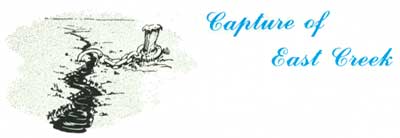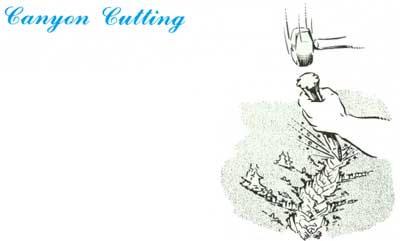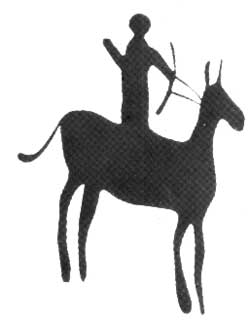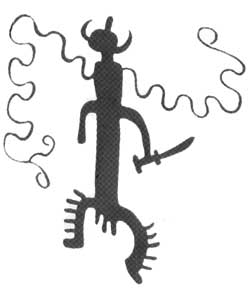
|
Geological Survey Bulletin 1508
The Geologic Story of Colorado National Monument |
THE AGE OF MAN

LIKE the dinosaurs before them, a few of the Tertiary mammals were so long on brawn and short on brains that they evolved into grotesque monsters and overspecialized themselves into early extinction. Fortunately, however, most of the mammals evolved more slowly and moderately into the forms we find today.
One group—the anthropoid primates—began to think, so they developed their brains rather than their brawn, particularly the Tertiary ancestors of man. Few remains of these ancestors have been found in Tertiary rocks, but many more have been discovered in rocks of the next geologic period—the Quaternary. Thus, this period may properly be regarded as the age of man, for man then began to dominate the Earth for better or for worse.
The Quaternary—latest and shortest of the geologic periods—is divided into the Pleistocene and Holocene (recent) Epochs (fig. 61).
The Ice Age

DURING THE PLEISTOCENE EPOCH, all continents of the Northern Hemisphere and some of the Southern Hemisphere were partly covered at least four times by huge glaciers. Each glacial advance in Europe and North America was ended by a warmer interval during which the glaciers melted and retreated northward; then, vegetation and soil had time to be come re-established. Thus, the Pleistocene has properly been called the ice age.
None of the continental glaciers reached the Monument or the Uncompahgre Plateau, or arch, but small alpine glaciers grew in the high Rocky Mountains to the east, sculpturing sharp-crested peaks and ridges and forming beautiful valleys and lakes. Many of the beautiful lakes on Grand Mesa were formed by glaciation, but some near the edges were formed by landslides.
The increased streamflow from the greater precipitation and from melting alpine glaciers in the Rockies, particularly during times of glacial retreat, helped the Colorado River cut through the rocks faster, thus assisting in the formation of Colorado National Monument as we see it today. The river carried thousands of cubic miles of sediment to the Gulf of California, including a lot of rock that once covered the Monument, and the river is still actively at work on this immense earthmoving project.
If the ancestral Colorado River carried sediment at about the same rate as the present river since the building of Hoover Dam, it may have carried about 3 cubic miles of sediment each century. Now most of the rock debris is being dumped into Lake Powell—the new reservoir behind Glen Canyon Dam. When this, Lake Mead, and other reservoirs ultimately become filled with sediment, the Gulf of California will again be the burial ground.
But other events during the Pleistocene also played a role in shaping the area. The Uncompahgre arch was again uplifted and deformed in the Pleistocene soon after the abandonment of Unaweep Canyon. This caused added tilting of the strata and more bending and breaking along some of the folds and faults in the Monument.
Capture of East Creek

EAST CREEK, which drains the northeastern half of Unaweep Canyon, was forced to change its course during the Pleistocene Epoch by another act of piracy. After capture of the Gunnison River by the newly routed Colorado River, East Creek joined the Gunnison by way of Cactus Park. Then, a tributary of North East Creek headed southward and captured East Creek, as shown in figure 34D.
Canyon Cutting

WHEN THE COLORADO RIVER was diverted into its new course through the Grand Valley past the Monument, the stream channel seems to have been only about 600 to 800 feet higher than it is today, but the present divide in Unaweep Canyon is now about 2,500 feet higher than the channel. The difference of 1,700 to 1,900 feet was caused by the additional uplift of the Uncompahgre arch during the Pleistocene.
Thus, the Grand Valley and its tributary canyons, such as those of Colorado National Monument, were cut since the abandonment of Unaweep Canyon, probably mainly during the Quaternary Period. This suggests that the cutting of the Monument's canyons began only about 2 million years ago, but that much of the canyon cutting occurred only a few hundred thousand years ago. Indeed, the canyons are still slowly being deepened, lengthened, and widened.
As you stand on any of the lookout points and gaze down into the canyons of the Monument, you may well wonder how such immense chasms could have been cut by such puny streams that are dry most of the time. The streams flow only for short periods after heavy thundershowers or after rapid melting of snow. If you are lucky enough to see them flow, you will notice that the water is red or brown because of the suspended mud, silt, and sand. If the flow is large, you may see or hear pebbles and cobbles rolling along the bed. Accordingly, the streams and their cutting tools are slowly deepening the channels. But, you may ask, how does this account for such wide, broad-bottomed, cliff-walled canyons? Such streams act mainly as storm sewers to carry off the rock debris formed by other types of erosion.
When cutting first began, the Monument's canyons were narrow, steep, and V-shaped. When the top of the hard, dark Proterozoic rocks was reached, however, downcutting slowed just as it had earlier in Unaweep Canyon. While the streams were thus hung up, other erosional processes caused the cliff walls to recede away from the streams, forming broad, flat-bottomed, U-shaped canyons.
Recession of the cliffs away from the middle of the canyons probably was caused partly by undercutting of the soft Chinle Formation by wind and in places by streams. This allowed slabs of the overlying Wingate Sandstone and younger rocks to break off and fall into the canyons—eventually to break up and to be carted off as sand and mud by streams.
But other processes are probably the ones chiefly responsible for the present shape and width of the canyons. The summer sun heats the cliff faces until they are hot to the touch, but in the present desert climate of the Monument the rocks cool rapidly after sundown. Oftentimes the hot cliff faces are chilled rapidly by summer thundershowers. Repeated heating, cooling, wetting, and drying causes expansion and contraction of the rocks so that thin layers break off and fall. This process goes on slowly even in winter on sun-facing cliffs, but it does not occur on the cliffs that face away from the winter sun.
Even more important, perhaps, is the alternate freezing at night and thawing by day on sun-facing cliff faces during the winter. Water in cracks near the cliff faces alternately freezes and melts, gradually prying off slabs of rock. Canyon walls that are shaded from the sun most of the winter, however, stay cold or frozen much of the winter; hence, they are not subject to repeated heating and cooling or freezing and thawing. Thus, you will notice that because of talus accumulation many such canyon walls are sloping rather than vertical.
To illustrate the above conjectures concerning the cutting and shaping of the canyons, let us consider several canyons that trend in different directions. We have seen in figure 12 that the left side of northeastward trending Red Canyon is a nearly vertical cliff that faces the sun most of the winter; whereas, the right side, which is shaded most of the winter, slopes gently enough to be climbed at many places. The sides of Ute Canyon, which trends more nearly northward (fig. 52), slope about equally, as would be expected. However, the west arm of the Canyon, which trends slightly southeastward, has sides whose slopes differ markedly (fig. 35).

|
| FALLEN ROCK, in west arm of Ute Canyon below waterfall, from Fallen Rock Overlook. Note that the sun-facing left side of canyon, containing the fallen block of Wingate Sandstone, is a vertical cliff; whereas, the shaded right side can be readily climbed. The right side contains a trail near the middle of the picture, but it is hidden by vegetation. (Fig. 35) |
This brings us to the remarkable transformation of the original V-shape of Unaweep Canyon to the beautiful U-shape of the present canyon, which is shown in figure 36. The abandonment of Unaweep Canyon discussed earlier removed the gigantic storm sewer that for millions of years carried off the products of vigorous erosion of the canyon walls by the processes just described. Rock materials that now fall from the cliffs of the inner gorge in hard Proterozoic rocks and that fall from the overlying softer sedimentary rocks simply pile up at the foot of the cliffs to form a canyon equally as U-shaped as those cut by glaciers in the high mountains. Indeed, Unaweep Canyon has been mistaken for a glacial canyon by many, including some geologists.

|
| UNAWEEP CANYON, looking southwest from rim of inner gorge cut in hard Proterozoic rocks, just to the right side of first cattle guard on Divide Road, near middle of sec. 16, T. 14S., R. 100 W., about 5 miles northeast of drainage divide shown in figure 34D. Drainage divide is just around the corner to the right of the most distant part of the canyon visible. Slope above vertical cliff on right consists of Chinle Formation, Wingate Sandstone, and flat crest of Entrada Sandstone (Kayenta Formation is absent). Paved road in canyon is Colorado Highway 141. (Fig. 36) |

A Look into the Future

THIS ENDS the brief geologic story of Colorado National Monument, except for a peek into the future, a description of trips through and around the Monument, and a comparison with other Parks and Monuments on the Plateau. The temporary nature of lakes, rivers, and even mountains has been discussed—the Monument of today and the new course of the Colorado River are no exceptions.
The Colorado River did not solve its problems by abandoning its hard-rock course in Unaweep Canyon in favor of a soft-rock course through Ruby and Westwater Canyons—it just postponed them. The river has again cut down into its old nemesis—the hard Proterozoic rock—in Ruby Canyon just within the Colorado border, in Westwater Canyon in Utah, and the Gunnison River has reached the hard rock at its confluence with Dominguez Creek, not far above Whitewater, as shown in figure 34D. Thus, once again hard rock is slowing down old man river, and will slow him down for a long time to come. Someday, Westwater and Ruby Canyons will be deep gorges like Unaweep Canyon. Then it is quite possible that another young tributary may sneak around the Uncompahgre arch some miles northwest of these canyons and pirate the river into a new soft-rock course.
By this time, the Monument will have changed appearance considerably. Some of the canyons will have come together by eating away the ramparts that separated them—just as the two entrances of Monument Canyon have already done. But as the lower canyons thus eliminate themselves, the headwaters will bite deeper into Piñon Mesa, so perhaps the Monument will simply creep slowly southwestward. However, renewed uplift, more volcanos, changes in climate, or other events could alter the picture.
Still, if the geologic clock ran as fast as the ones we use, the picture of the Monument we see today would be on the screen only a small fraction of a split second. But the geologic clock ticks on, slowly but surely, and, someday, the Holocene Epoch in which we live will become just another brief chapter in the long geologic history of the Earth.

| <<< Previous | <<< Contents >>> | Next >>> |
bul/1508/sec10.htm
Last Updated: 8-Jan-2007